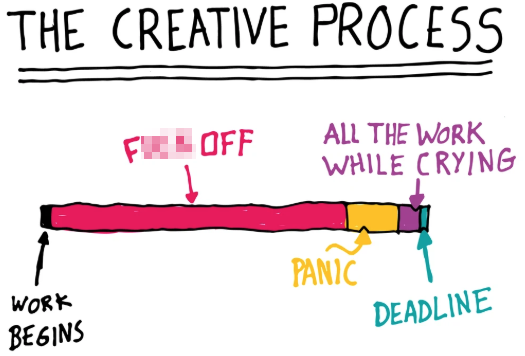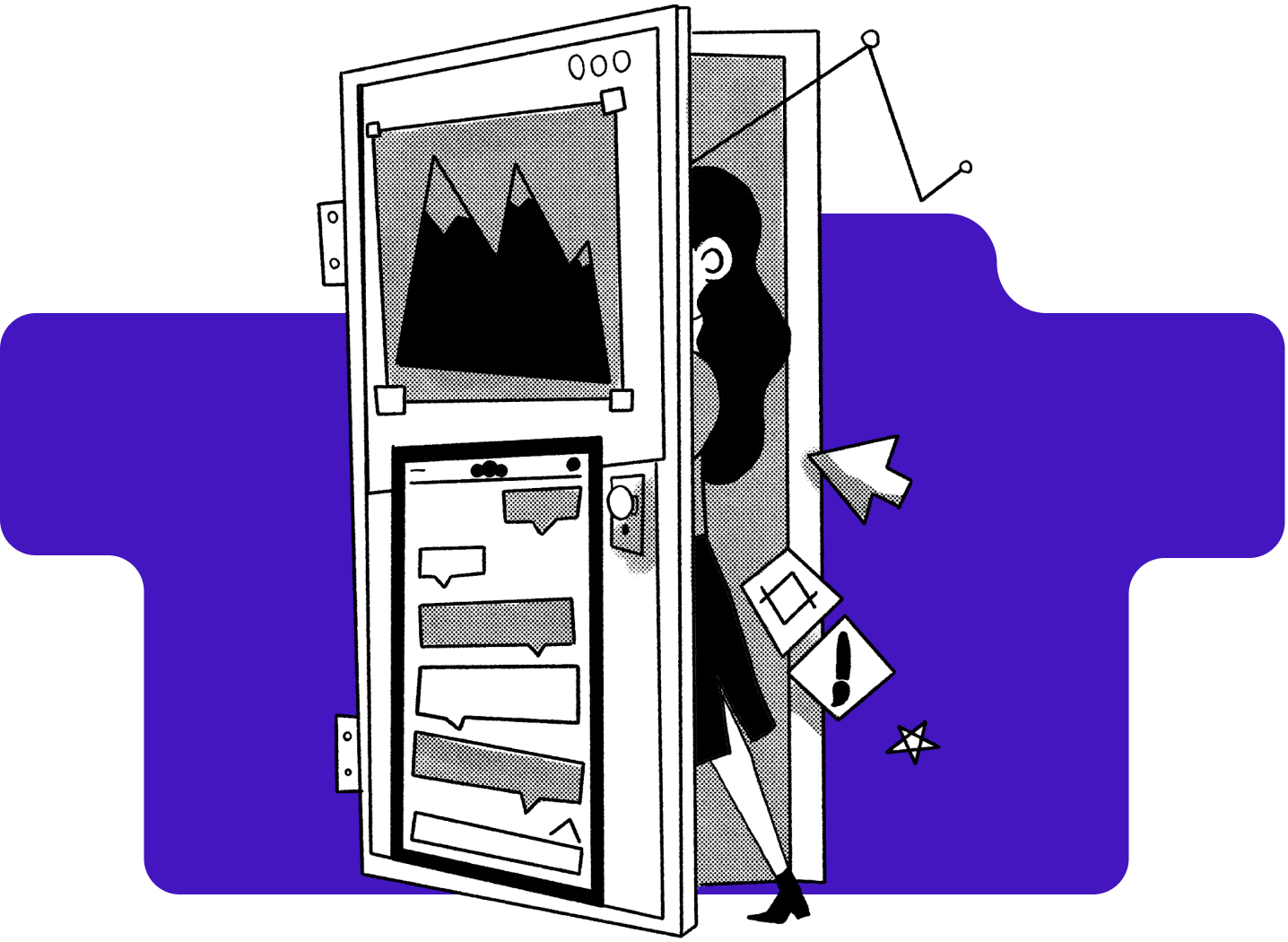The creative process looks different for everyone.
Personally, my creative process involves a lot of procrastination, and looks something like this:

As I write this, I’m returning to my desk from a series of inversion yoga poses—in a literal attempt to dump the words from my head.
In his highly-actionable book, How to Have Great Ideas: A Guide to Creative Thinking, John Ingledew defines creative thinking as “the process of generating the ideas that make breakthroughs possible.”
These creative breakthroughs can lead to solutions for seemingly unsolvable problems.
If you’re in a position where it’s necessary to have creative ideas quickly and repeatedly—like a career in UX/UI design—it’s important to understand which conditions make you most creatively productive.
In his book, Ingledew provides a wealth of exercises for the imagination. As he says, “it’s important to warm up and exercise the imagination so that it’s nimble, mobile, and speedy.”
Inspired by this book, we compiled seven exercises here that will flex your creative brain!
Warm up
To warm up, start to think about your own creative process.
The last time you were actively creative, what did your environment look like? What did it feel like? Who were you with? What time was it? What was your routine that day?
Record those reflections, and read on to see how you might optimize your creative process further.
Remember, what fuels your co-worker creatively, might not fuel you in the same way.
Many people claim they actually work better under tight deadlines. Crew members of the always on-point TV show Saturday Night Live feel this—all SNL shorts are put together in 72 hours or less!
Use these seven exercises to help set the mood for your next creative endeavour.
1. Surround Yourself with Inspiration
Whether it be at your cubicle in an office surrounded by co-workers or in the comfort of your personal home office, it’s important to surround yourself with inspiration.
Our physical spaces and the things we see on a regular basis can play a big role in how we create.
Ingledew says, “Having a place in which to be alone is vital to the process of thinking, both in a concentrated manner and in the opposite way—by letting the mind wander.
“Having your own space offers freedom: the freedom to make progress at your own pace and experiment, make a mess and make mistakes without fear of intervention or criticism by others. A private, secluded space—even in a communal environment—is necessary to form and shape your thoughts.”
Studios, studies, and sheds can serve as the perfect place for creative outlets, too. “Once immersed in your own world you can feel free from the normal rules, conventions, formalities and hierarchies of the nine-to-five world outside,” Ingledew continues.
Empty, cold, cubicle-ridden office plans are not conducive to great ideas.
Wherever you work, or create, try adorning it with:
- Work by heroes, mentors, or other influencers
- Things you love or are curious about
- Variety of imagery, objects, and words
- Your own work that you’re proud of
By surrounding yourself with these micro-doses of inspiration, you open yourself up to ideas by osmosis—the process of gradual or unconscious absorption.

Exercise #1
Add four new pieces of inspiration to your work space.
2. Write Your Creative Declaration
Ingledew says, “Manifestos, mottos and mantras are visible reminders to stick to your guns, not to let your ideas down and not to forget your principles when starting a new challenge.
“They command you not to default—the desire of the mind to avoid trying something new by returning to something that is usual or standard.”
The same way you might repeat a mantra to yourself in the mirror each morning, write a manifesto (longer), motto (shorter), or mantra (shortest), that you can turn and reflect upon when getting in the mood to be creative.

Source: Austin Kleon
Check out these creative examples of mottos from the design world:
- “Create the best, for the most, for the least”—the Eames Studio
- “Form follows function”—Modernist movement
- “Encourage wild ideas” and “Build on the ideas of others”—IDEO
- “Creativity = Play. Don’t play safe!”—Johnny Firewater
Exercise #2
Come up with a manifesto, motto, or mantra for yourself and seek to clarify your creative point of view.
3. Question Everything
My favorite proverb is: “There is only one stupid question in this world, and that is the question that does not get asked.”
As a teen, I excelled on the debate team. My parents had thought I would go into a career in law. On the other hand, I was always questioning authority.
Two years into my degree in English, a mentor verbally observed that I was always asking “Why?” He said that a career in journalism would suit me well. I agreed, and for the first time, really realized how important it was to be curious.
Ingledew says, “Ruthlessly interrogating a problem will extract information that leads to ideas. Use questions to challenge assumptions—things that seem to be accepted as certain or true.
“See the problem as a puzzle, and use questions to gather as many pieces as possible by methodically establishing as many facts as you can.”
Use questions to open up problems. And make it a point to always ask questions—especially the questions you’re afraid to ask.
Exercise #3
Have a conversation using only questions. (Think: Drawing a Queen card in the drinking game, “Kings”.)
4. Tell a Story
Storytelling can be epic—think Harry Potter.
Stories can also be seemingly simple. Ernest Hemingway famously bet his writer friends that he could write a novel in just six words.
The result? “For sale: baby shoes, never worn.” Stories can be loaded—and they usually are.
Stories can be used to promote trust, and persuade.
Scientists are discovering that chemicals like cortisol, dopamine, and oxytocin are released in the brain when we’re told a story. These chemicals formulate memories, keep us engaged, and encourage empathy.
Perhaps more importantly, as Harvard Business Review explains, “storytelling is central to meaning-making and sense-making. It is through story that our minds form and examine our own truths and beliefs, as well as discern how they correlate with the truths and beliefs of others.
“Through story listening, we gain new perspectives and a better understanding of the world around us. We challenge and expand our own understanding by exploring how others see and understand the world through their lens.
“By sharing and listening to each other’s stories, we all get a little bit closer to what’s true.”
Exercise #4
Write a story using only 140 characters on Twitter.
5. Act Like a Kid Again
Kids are innately imaginative.
How could they not be? They’re surrounded by visually stimulating fairy tales, cleverly-written cartoons, and the wonderful world of Walt Disney.
Revive that feeling of endless imagination by recreating play time the next time you’re seeking to be creative.
After all, it’s on playgrounds that children display many of the skills which are highly coveted by companies looking to hire creative individuals:
- Spontaneity
- Improvisation
- Ingenuity
- Verbal dexterity
- Invention
- Enthusiasm
- Collaboration
- Teamwork
“Shedding the constraints of adult life and acting like a kid again can be immensely productive when setting out to generate ideas,” says Ingledew.
Companies like Google design office spaces with the intention of firing up their employees’ creativity. This often means building tactile, interactive physical environments.


Google’s offices in Tel Aviv and Dublin
Exercise #5
Break out some Legos, and build!
6. Visualize It
“The simple act of drawing an idea helps develop it: initial ideas can be indistinct and fragile,” Ingledew explains, “and visualizing helps these quarter- or half-formed ideas become fully formed.”
You don’t have to be good at art. Just visualize your ideas however you can.
Visualizing ideas helps to empty them from your mind. So even if it isn’t the right idea, this process will help to declutter your brain.
Exercise #6
Grab a pen and paper, and visualize any idea or thought that comes to mind.
7. Take Notice
Do you ever see faces hiding in everyday objects? Do clouds change shape, almost as if they’re putting on a puppet show? This phenomenon actually has a name, pareidolia, and a lot of people experience it.


Source: Bored Panda
Your creative mind is always at work. Professor Guy Claxton observed that, “creative people are expert noticers.”
To notice new things, try taking a different route to somewhere you regularly visit. Alternatively, take different modes of transportation to work throughout the week.
Whatever you do, break your usual pattern, and you’ll begin to see things differently.
Appreciate new perspectives, but also consider your own unique perspective.
Our Front-End Developer here at Designlab, Ezra Lamb, has this to say about everyday creativity: “Embrace whatever skills and background knowledge you have, and use that to bring your unique perspective to whatever form of creativity you’re trying out. We can’t have innovation without people from different backgrounds and perspectives.”
Traveling is also a great way to boost your creativity, as it opens up new pathways and modes of thinking. As a stranger in a new land, your eyes are wide open. Embrace it.
Exercise #7
Go somewhere you’ve never been before, whether it’s the attic in your house, a new coffee shop, or somewhere more dramatic. Notice your novel and unique point of view.
In conclusion...
Ingledew reassures all of us creatives: “The more you practice solving problems and finding ideas that work, the easier it gets.
“You will develop a greater understanding of the methods, processes, activities and types of thinking that produce results for you, and become more confident in your own abilities.”
As someone who often succumbs to creative blocks, I’m looking forward to putting Ingledew’s advice into action in my own creative process!
Illustration by Gina Medranda
Want to develop your creative ideas every day? Hundreds of people have become designers with our UX Academy career accelerator. Find out more



.svg)







%20(1)-min.png)






